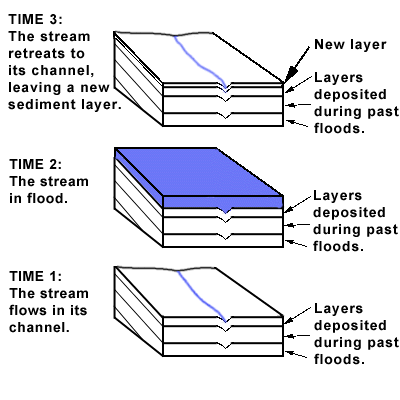- The Hypothesis of Differential Erosion
- The Hypothesis of Deposition
- The Hypothesis of Deformation.
It is important to note that it is quite acceptable for you to conclude that, for a given N.Y.C. landform, (a) more than one hypothesis has good evidence to support it and (b) that you have no way to choose between them, given the available data.
Thus, the gently sloping plain in southern Brooklyn satisfies the tests applied for both the hypothesis of deposition and the hypothesis of deformation, as explained below.

- Support for Deposition:
Deposition is supported by the loose character of the sediment. The good sorting and layering supports the action of flowing water (glacial meltwater streams or ordinary stream flooding). Since streams flow down inclined surfaces, the deposits themselves may form inclined layers (see drawing to right). The inclination of the layers does not necessarily indicate that the layers have been tilted. The top of the topmost layer may form the surface of the land; unless the top layer has been unevenly eroded, the layering and the land surface may be parallel.

- Support for Deformation
Deformation is supported by the presence of inclined layers that are parallel to the surface of the land. The layers may have been deposited horizontally or at a lower inclination than they now display. Their present inclination is due to tilting of the layers subsequent to their deposition.


 Indicate your conclusions concerning the origin of the four NYC landforms.
Indicate your conclusions concerning the origin of the four NYC landforms.